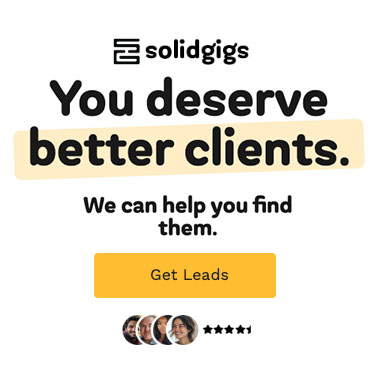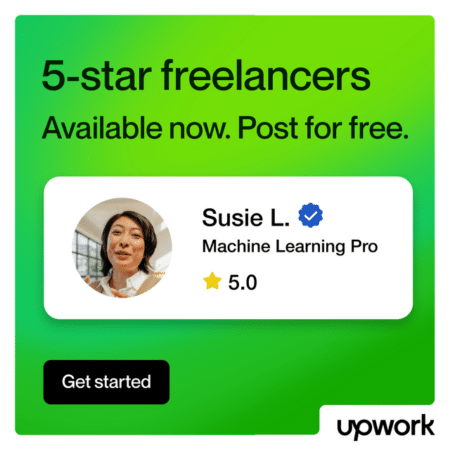Want more clients from your portfolio website? This checklist should help you get it up to speed – and help you grow.
A lot of these things I’ve written about in the past, but I thought it’d be helpful to put them all in one place. That way you can keep coming back to this list, and using it to improve your website and grow.
And of course, a lot of it is brand new too 😉
👋 Psst...Have you seen the all-new Feedcoyote yet? They've got a new look, more freelance opportunities, and the best collaboration tool for freelancers! Join over 100,000 fellow freelancers who network, find clients, and grow their business with Feedcoyote. Join for Free »
After you read it, I’d love to hear your thoughts and what’s worked well for you.
Cool? Then let’s dig in:
1. Everything must pass the “so what?” test
People intrinsically view anything — whether it’s advertising or the dog next door — with these questions subconsciously in their minds:
“So what? Why should I care? What’s in it for me?”
A website that just talks about how long you’ve been designing, where you’ve studied, and what you can do does not pass the “so what?” test.
How do you pass it? It’s pretty simple.
Everything on your website must circle back to two things:
Your potential clients’ 1) burning problems… or 2) their desired goals. Or both.
I see a lot of statements on designers’ websites like “I’ve been designing for 15 years” and “I’m a multi-disciplinary designer.”
But…so what? Why does that matter? I’ve been living for 27 years and still not sure I’m getting it right. How long you’ve done something, or the fact that you can do it, doesn’t tell us enough.
Explain why those 15 years are significant. Explain why they make you the right choice for potential clients.
You have to take your claims a step further and connect them to what your clients want and need.
For example:
“In the past 15 years, I’ve had the opportunity to help businesses of all shapes and sizes grow through better design.”
See how that compares to:

“I’ve been designing for the past 15 years.”
Or another example:
“Whether you’re looking for help with print, digital, or both – I’m here to help you grow.”
See how that compares to:
“I’m a multi-disciplinary designer.”
TL;DR – (too long; didn’t read)
Don’t just state what you do or for how long you’ve done it – tell your prospects how it will impact their lives.

2. Social Proof
The next thing you need is other people backing up your claims. Why? Because we’re all insecure beings who turn to others for approval when making decisions.
That’s part of it anyway 😉
The moment we hear something that sounds really good… or too good to be true… or somewhere in-between… we automatically look around to see if anyone else believes it or can verify it.
If you come across a website that says, “Our city’s best sushi!” – you’ll immediately look up reviews to see if that’s true.
If you can’t find reviews, you’re likely going to doubt their claim, and not risk trying it out.

Clients feel the same way about you.
Your website is where you’re promising them you’re the right person for them to work with – they want to feel safety in numbers.
Make sure you give them that safety through testimonials that cover the most common objections you get… and make sure you give them enough testimonials to make them say to themselves,
“Okay, I get it, you know how to help people like me.”
TL;DR
Make sure reviews are present on every page of your website – and then you should also have a separate page dedicated just to reviews too.
Give your prospects the “crowd approval” they need.
3. Simple, brainless functionality
People view websites in a half-awake state. In fact, just so you can see how people will view your site, do this…
Tomorrow morning, when you first wake up, load up any website.
Welcome to your prospects’ world! It’s not that they’re “dumb” or “slow” or anything, people just don’t engage things with their full attention until they feel like what they’re looking at will truly offer them some kind of reward.
That means, until you make them feel this way, they’re pretty much zombies.
Your website has to have a super clear, simple, easy flow to it that’s mindless to navigate. They have to just “know” what they’re supposed to do upon landing on it without having to think.
Use clear visual hierarchy, headlines, and buttons to direct the flow of your website.
Think out every possible scenario of what people will do.
“Okay, if someone lands on my home page, and immediately hits the ‘portfolio’ button without reading the full sales pitch on the home page, what info do I need to make sure is present in the ‘portfolio’ page to get my message across?”
Or:
“If someone reads my entire home page from top to bottom – what should they do when they get to the end of it?”
Your website has to connect and flow together and be intuitive.
At which point is it intuitive for someone to click to fill out a form? At which point is it more intuitive to send them to a portfolio page or piece?
TL;DR
Make the layout and navigation of your website so simple a 5 year old could use it. Or people will just hit the “back” button as soon as they arrive.
4. Be strategic & plentiful with calls to action
Calls to action are sort of like asking someone to marry you.
Only throw the big question out there when you’re sure you’ve presented enough of a case for them to say “yes”.
If you have a striking headline on your home page that clearly says what you do, and why you’re a rock star – that might be enough for some. Give them a chance to reach out to you right then and there.
But also know that for others, they’ll want more info, so they’ll scroll for more info or click to another page to learn more.
Present more of your strengths then on these other pages. No one is searching through them if they are 100% ready to call you.
Someone who clicks on other pages is basically saying, “I’m intrigued – but need to know more before I’m ready to reach out.”
They’re also looking for any reason to NOT reach out too.
Cover objections, explain how you help people, then, every time you get the feeling, “Okay, I’d definitely reach out after reading that!” – give them the chance to do so.
TL;DR
Every time you present a rock solid reason why you’re the obvious choice that would inspire anyone to work with you, follow it up with a call to action.
5. Counter objections
What questions do you hear the most in your sales process? Which ones do you have to answer each time before a prospect becomes a client?
Cover those objections and questions on your website too.
In fact, if you cover them well enough, you won’t hear those questions any more when people finally reach out.
Do people ask about price? ETA? How your whole process works? What they get out of it? How you’re different from other designers?
Answer these questions throughout your copy, always making sure to stick to the “so what?” test.
In #4, I stated that people are always looking for a reason to NOT reach out to you. If they have lingering questions, doubts, or objections – that’s a good enough reason for most to not call or email.
So cover objections, questions, and concerns in a way that shows how good you truly are.
TL;DR
People naturally have questions and suspicions about you. Use your experience with previous sales consultations to load your website up with answers to the most common questions and concerns you get.
6. Clear visual hierarchy
This is so critical for website success – and so lacking in our industry, too.
Upon landing on your website people have to automatically know what the first thing they should be looking at is, then the second, third, and so on.
“David, I know this, I’m a designer!”
I hear ya 😉 But I’m writing it here because I see too many of my fellow designers’ websites majorly lacking it!
If you’re ever confused or unsure about how to instill good visual hierarchy throughout your site — or you’re not sure if you’re really nailing it — visit your favorite blogs.
By their very nature, blog articles have great visual hierarchy.
There’s always your large headline which you know you should read first. Then, as you scroll, the content is broken up into sub-headings and paragraph blocks, quotation blocks, etc.
These typographic elements let you know what’s important if you’re skimming, highlight key points, and keep your eyes flowing nicely through it all.
You want your content formatted like this too. The eye should naturally flow through it like it would a newspaper or blog article.
TL;DR
Reading through your website should be as nice and easy as reading a great blog post. Break up your content with headlines, subheads, bold phrases, and more.
7. Pre-frame your portfolio pieces
Something else I see a lot of is portfolio pieces just plopped down on a website. No explanation. No frame of reference. Nothing.
When you do this, you’re simply asking the prospect, “Do you like it?”
And they look from piece to piece saying “yes” or “no” in their minds.
Instead, pre-frame every piece you display by explaining the client’s challenges / problems they came to you with, the process you went through to create your solution, and the results the piece generated.
(That last part, the results, is really important.)
Then, after reading all that, they’ll view the piece in a completely different way. They’ll look for your thought process, and view it as a successful piece – not just a “pretty” or “not pretty” one.
In fact, even if they don’t personally like a piece – they’ll still respect it and you. Because you can’t argue with the numbers.
TL;DR
Don’t just throw your work out there for all to see… explain why it’s so effective, and the results it helped produce.
8. Keep your copy simple
Write in short sentences. Break up paragraphs so they don’t have more than a few lines.
And don’t use big words like “multi-disciplinary!”
Keep it simple, easy, and fun to read.
Is your content riddled with huge, chunky paragraphs? Do you use super long sentences? Are they full of big words and phrases like “accomplishments” and “specializing in client-centered design?”
Use little words that mean a lot in place of big words that mean nothing.
Instead of “accomplishments” or “accomplish your goals” – state what those accomplishments and goals are.
Instead of “specializing in client-centered design” – explain what the heck that is in a way that makes sense and is appealing to anyone.
Before:
“I specialize in client-centered design that helps businesses accomplish their unique goals and overcome their diverse challenges.”
After:
“My design tells your business’s story in just the way your market needs to see it. That’s how I’ve been able to help my clients attract so many more customers – while creating a beautiful image they truly love.”
TL;DR
Keep your copy simple. Keep the language easy. Keep the paragraphs small. It’s okay to have a lot of writing – it just has to be presented in a way that’s actually pleasant to read.
My “after” example is longer than the “before” one – but which did you enjoy reading more?
9. Make it “you”
You bring something special to the table.
Design is a science – but it’s also an art, and art is an expression of your soul.
No one can get your soul from anyone else but you.
So make sure people can feel that soul in the design of your website. Put your heart into it.
That’s not just “new age voodoo” or anything either. This is a key ingredient in every project I’m a part of – and every time my soul is there, the project takes off.
It’s also the trademark of all great design. It’s full of life, heart, and spirit.
It transcends the colors and the shapes and makes you feel and experience something deeper. Something more pure.
If clients feel that on your website – there isn’t much else you have to do.
(But you should still do the 8 things above too! 🙂 )
Okay, your turn. Have any tips of your own? What’s worked well for you? Have questions?
Leave a comment. I’d love to hear your thoughts and help in any way I can.
Keep the conversation going...
Over 10,000 of us are having daily conversations over in our free Facebook group and we'd love to see you there. Join us!




That’s truly an eye opener!
Nice! That’s the idea 😀 Glad to hear it helped
Thank you for this great article – I loved the real examples of copy. It helps so much!!!
Whoo! Awesome. Thanks for sharing as well 😀
Hi @David I am about to revamp my freelance graphic design portfolio website and this is some amazing suggestions you have shared.
Thanks a lot for this 🙂
Nice! 😀 😀 😀
Thank you too
Another great post, David!
One of those that make me go to my website and make ANOTHER small change.
This is a good habit also, to make improvements every now and then.
A website or a blog should never be static.
I always enjoy reading you!
100%
I am always always always tweaking
And thanks so much, that really warms my heart 🙂
Thanks for these great insights, David.
Jesse Hausler, Principal Accessibility Specialist at Salesforce, also shared another great insight — 7 things every designer needs to know about accessibility — that we can add to this “9-point checklist…”:
https://medium.com/salesforce-ux/7-things-every-designer-needs-to-know-about-accessibility-64f105f0881b#.f6eeb1k01
Here’s the key point I recalled from Jesse’s article aforementioned:
“Design for the diverse set of users who will be interacting with your product [or in this case your website]”
Nice find! Thanks for sharing 😀
I needed this. Currently working on my website copy. Thanks alot
Nice. Share it when you’re done! 😀
Incredible checklist David, so helpful! The one thing I always stress about portfolio pieces is show the work in context and if possible real life documented versions, not just flat jpgs exported from the artwork.
If it’s a window vinyl go and take a photo of it in situ and if the work isn’t there any more, take a photo of the window and comp it in. If it’s a book cover, or a magazine or whatever, get samples and photograph it.
Great advice ????????
Thanks for your thoughts 🙂
Great article, David! I really enjoyed the points you make on messaging! Copy is something I am always struggling to fine-tune.
Kristin! Hey! 😀
Thank you, really appreciate that.
That’s good that you recognize the struggle. That means you actually see where you need to grow.
You can’t grow without seeing that.
David
It was really self-validating to go through this list and see my site’s on track with a lot of these points! But there’s still some gold in here that I need to apply immediately – Thanks David for solid advice once again!
Nice! Thanks so much for sharing all that, really appreciate it 🙂